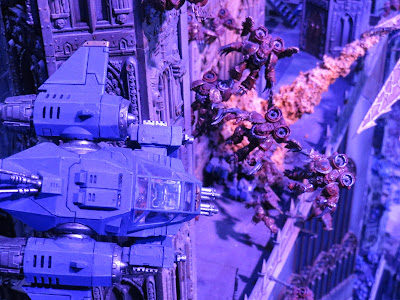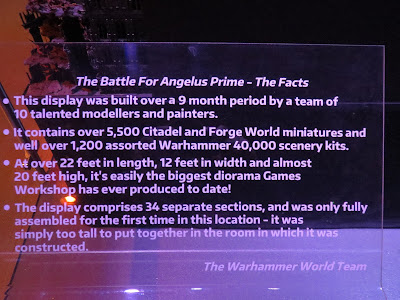While moving from display case to display case, one thing that struck me was how much better most of the Eavy Metal painted miniatures looked in person, versus how they looked in pics in White Dwarf and online. I may have mentioned this in my earlier post, when discussing the painted minis from the 80s, 90s, and 00s, but the same was true with the most recently produced miniatures. Miniature photography and publication quality may have improved somewhat since those days, but they still don't hold a candle to being able to see these works of art in person.
Certainly, viewing my humble pics (taken with a simple point and shoot camera under less than ideal photographic circumstances) are not going to do the painting justice, but it's interesting how they give a slightly different perspective on the models than the studio photos.
 |
| A damn impressive magic chicken |
 |
| Love the buttery blends / seamless transitions |
This is not a criticism by any means. The same is true for any painted unit or army... if you tried to paint every single model to the same standard as competition single miniature entry, it would be nearly impossible to get anything done. Certainly it would be impossible to get something like this huge diorama completed in a reasonable amount of time:
 |
| A great example of how great things look from a distance, and up close. |
The above pic is worth checking out for this reason. When looked at as a whole, it's mind-blowing. There's a huge amount of attention to detail in its construction and composition. However, take a close look at the green skin of the Glottkin in the bottom left corner of the pic. You can tell that it was rushed a bit, as there's little shading, highlighting, and blending done... like a low-resolution pic, it's meant to be viewed from an arm's length away at least. "Low Resolution Painting" is possibly a good term for this approach.
The above statue is a great example of the level of attention that went into the terrain as well. While not as eye-catching as the monsters, war machines, and foot soldiers, you would be missing out on a lot of effort if you didn't stop to appreciate the work done in the settings and backdrops.
It's hard to imagine being able to see such huge dioramas anywhere else. It's not like someone could construct the above work, and then bring it to a painting competition like the Golden Demons or Crystal Brush as their entry...
Again, these monstrously huge dioramas were made up a many, many little vignettes like this scene above. The dwarf slayers, assaulting the giant Skaven Abomination, was something that could conceivably be done up as a "large" diorama in your home, in your local game store display case, or as an entry at a painting competition. However, here at Warhammer World, it was just one little detail set in a large city-scale conflict.
Photographing these miniatures was a challenge. While the overhead and cabinet lighting was pretty strong, it did bounce and reflect off all the glass in the rooms, and you had to move the camera around a lot to see if you could find an angle where you wouldn't accidentally end up taking a picture of your own reflection instead.
When we were done with the Age of Sigmar hall, it was time to go through the next set of doors into the Warhammer 40,000 hall.
There were plenty of Forgeworld resin models in amongst the regular Citadel miniatures, especially in the Horus Heresy section:
I have a particular fondness for the Imperial Fists Space Marines chapter. I once had a Fists army, back when there was almost no mention of that chapter in the 40K rulebooks (2nd edition 40k... in the early 90s). After having played Imperial Guard and Orks, I really wanted a Space Marine army of my own. At the time, all the better known chapters were well represented in my gaming circle of friends, and always wanting to be different and unique, I went with a chapter that hardly anyone was familiar with at the time. I was inspired by one of the very first Warhammer 40k novels ever published, way back in 1993, "Space Marine" by Ian Watson, where the marines in question were ones recruited into the Imperial Fists.
https://www.trackofwords.com/2017/07/19/forgotten-texts-space-marine-by-ian-watson/
http://www.thebolthole.org/blog/2017/12/08/space-marine-and-an-interview-with-a-legend/
Once I started painting this army, I quickly discovered another possible reason why the Fists weren't well represented in gaming circles at the time... yellow gaming paints had almost no opacity, and was more akin to a thick glaze. My old teacher, Mathieu Fontaine, once explained that yellow pigment is pricier than other colours, and so with gaming paints, yellow pots typically had less pigment in them so that that all the paints in the range could be priced the same (whereas canvas artists pay more for certain colours, depending on how pricey the pigment in them was).
I ended up selling or trading that army away years later, just around the time that the chapter was gaining popularity. I was no longer the unique snowflake any more, and moved on to a Sisters of Battle army. However, it was (and still is) very satisfying to see the bright yellow sons of Dorn being featured in many novels, painting competitions, and gaming events.
Pics of lesser chapters below:
When I look at the pics of the following diorama, I shudder to think what the retail cost of all this plastic and resin would be:
Ah, the Sisters of Battle. My own army has been something I have been working on, off and on, for nearly the last two decades.
When you consider that these paintjobs are nearly old enough to legally drink and vote (although hopefully not at the same time) in most countries, you can't help but be impressed at how well they have held up (physically and artistically).
Below is a large diorama depicting the battle between The Emperor's Children and the Iron Hands on Isstvan V, during the Horus Heresy.
Of course, the above vignette is the climatic duel between the two Primarchs. If the diorama as a whole was a giant wedding cake, this would be the cake topper.
"Wedding cake" may not be such a good analogy here. Perhaps if there was such a thing as a "Divorce Cake", then that would be a better analogy...
And even more giant size dioramas:
Also, a nearby display case showcased an Adeptus Mechanicus army that had been painted by the staff in an extremely short amount of time, presumably while being threatened with whips and cattle prods.
Some classic Perry Twins sculpted Tallarn Imperial Guardsmen:
And some Forgeworld Guardsmen, released years later:
Looks like Commissar Yarrick was on leave at the time, probably having his picture taken by the White Dwarf crew for some battle report:
Now, the above diorama was the last one in the Warhammer 40,000 room, and it was damn impressive. However, the diorama in the NEXT room was so huge, there was an entire staircase set around it:
Well, I'm pretty sure the staircase was there first. But it was a great place to put a diorama... one could ascend or descend the stairs to get a better look at the whole battle from various angles. And the room was lit with slow, ever changing colours.
Mounted along one wall, where one might expect an emergency fire extinguisher to be placed, was this exquisite life size chainsword.
 |
| Marneus Calgar and his honour guard face off against a Bloodthirster of Khorne |
 |
| Chaos Marines, doing Parkour with jump packs... |
 |
| Just call me, "Smaug"... |
When you almost fail to notice the huge Forgeworld Warlord Titan, you know this diorama was HUGE! The Knights and Rhinos next to it look like Hot Wheels cars.
The following plaque details the work that went into this mammoth display:
That's it for now. Hard to believe that there's more, but part III is coming up. Just a few more pics of dioramas, displays, the gaming hall, and Bugman's Bar to come!



















































































No comments:
Post a Comment